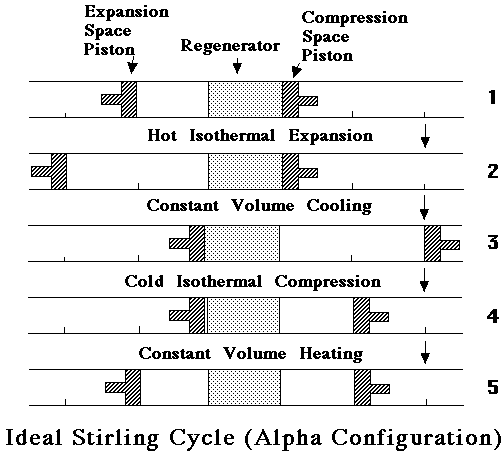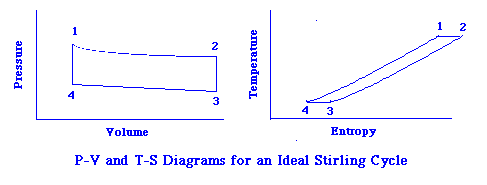
The Stirling cycle can be applied as a heat engine cycle in which heat is accepted at a high temperature, rejected at a lower temperature, and net work or power is produced. Or the cycle can be applied as a refrigeration/heat pump cycle in which net work is done on the Stirling device and, heat is accepted at a low temperature and rejected at a higher temperature; if the useful heat is that which is accepted at the low temperature, then the device is being used as a refrigeration or cooling device; if the useful heat is that which is being rejected at the higher temperature, then the cycle is being used as a heating device.
The alpha configuration (Walker 1973, see References below) ideal Stirling cycle is useful for getting an introductory appreciation of how a Stirling cycle works. The alpha configuration shown in the image below includes: an expansion space, an expansion space piston, a porous matrix regenerator with negligible volume, a compression space, and a compression space piston.

The alpha configuration ideal Stirling cycle can be described as follows with reference to the above image: (1->2) With the compression piston fixed at its innermost position relative to the regenerator, the expansion piston moves from its intermediate position to its outermost position; during this piston motion, the gas expands from minimum to maximum volume, isothermally, at the hottest cycle temperature; (2->3) the next phase of the cycle involves movement of expansion and compression pistons together to the right; the gas is cooled at constant volume as it passes through the regenerator from the hot to the innermost position while the compression piston moves from innermost to outermost position; heat from the gas is stored in the regenerator matrix to be recovered later; (3->4) the compression phase of the cycle is next; with expansion piston fixed, the compression piston moves from its outermost position to its intermediate position; during this period gas is compressed isothermally at the coldest cycle temperature, from maximum to minimum volume; and (4->1) the final phase, constant volume heating, returns the pistons to their original positions; during this phase, the two pistons move together to the left--the compression piston from intermediate to innermost position and the expansion piston from innermost to intermediate position; the gas recovers the heat that was stored earlier in the regenerator matrix.

P-V and T-S diagrams corresponding to the process described above are shown in the above image. For a heat engine application, each portion of these diagrams can be correlated with the process described above--as follows: The useful work produced by the cycle is represented by the areas inside the P-V and T-S diagrams. In order to achieve positive work production, the work produced by the gas during expansion (equal to the heat in through the expansion space) must exceed the work absorbed by the gas during compression (equal to the heat rejected from the compression space).
More complete discussions of the ideal Stirling cycle, and more practical adaptations of the cycle, can be found in West (1986), Walker (1973), Urieli and Berchowitz (1984), Reader and Hooper (1983), and Organ (1992). Many general thermodynamic texts contain brief discussions of the ideal Stirling cycle. It should be remembered that the ideal cycle neglects all thermodynamic irreversibilities; therefore, to get useful estimates of real engine performance using ideal cycle calculations, ideal power and efficiency must be multiplied by "experience factors".
The above material was abstracted and/or derived from information on the Stirling cycle that was prepared by members of the Stirling Technology Branch for a chapter in El-Genk (1994), below.
El-Genk, Mohamed S.; Editor (1994) A Critical Review of SPACE NUCLEAR POWER AND PROPULSION 1984-1993, American Institute of Physics Press
Organ, A. J. (1992) Thermodynamics and Gas Dynamics of the Stirling Cycle Machine, Cambridge University Press
Reader, G. T. and Hooper, C. (1983) Stirling Engines, E. & F. N. Spon
Urieli, I. and Berchowitz, D. M. (1984) Stirling Cycle Engine Analysis, Adam Hilger Ltd.
Walker, G. (1973) Stirling-Cycle Machines, Oxford University Press
West, C. D. (1986) Principles and Applications or Stirling Engines, Van Nostrand Reinhold Company, Inc.
Last updated: Wednesday, May 3, 1995